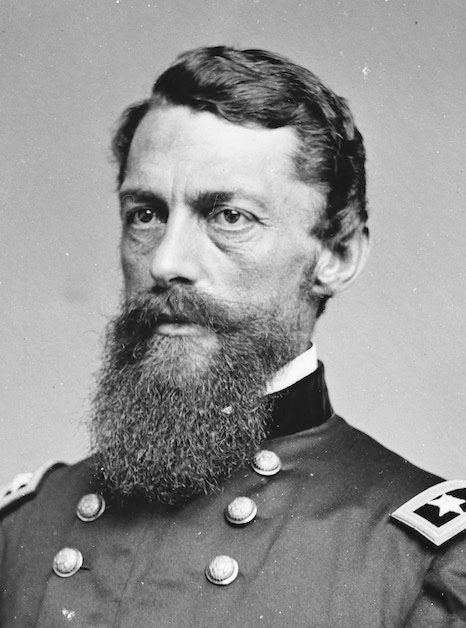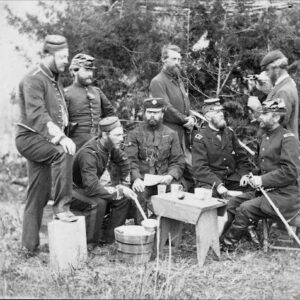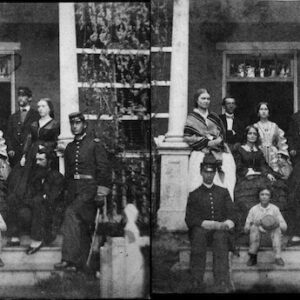Tag: Stoneman (George)
 Wikipedia says: George Stoneman Jr. (August 8, 1822 – September 5, 1894) was a United States Army cavalry officer and politician who served as the fifteenth Governor of California from 1883 to 1887. He was trained at West Point, where his roommate was Stonewall Jackson, and graduated in 1846. Stoneman served in the Army for thirty-six years, though he was relieved of command in 1871. During this time, he was involved in multiple conflicts, including the Mexican–American War, though he did not see any combat, the Yuma War, and the American Civil War. In 1861, Stoneman was promoted to Brigadier General, and was later put in command of the Army of the Potomac’s 3rd Infantry Corps, and subsequently the newly-created cavalry corps.
Wikipedia says: George Stoneman Jr. (August 8, 1822 – September 5, 1894) was a United States Army cavalry officer and politician who served as the fifteenth Governor of California from 1883 to 1887. He was trained at West Point, where his roommate was Stonewall Jackson, and graduated in 1846. Stoneman served in the Army for thirty-six years, though he was relieved of command in 1871. During this time, he was involved in multiple conflicts, including the Mexican–American War, though he did not see any combat, the Yuma War, and the American Civil War. In 1861, Stoneman was promoted to Brigadier General, and was later put in command of the Army of the Potomac’s 3rd Infantry Corps, and subsequently the newly-created cavalry corps.
At the Battle of Chancellorsville in 1863, under the command of Joseph Hooker, Stoneman failed in an ambitious attempt to penetrate behind enemy lines, getting bogged down at an important river crossing. Hooker placed much of the blame for the Union army’s defeat on Stoneman. His sharp criticism may have been in part intended to deflect blame placed on himself for the North’s defeat.
While commanding cavalry under William Tecumseh Sherman in Georgia, Stoneman was captured, but soon exchanged. During the early years after the American Civil War, Stoneman commanded occupying troops at Memphis, Tennessee, who were stationed at Fort Pickering. He had turned over control of law enforcement to the civilian government by May 1866, when the Memphis riots broke out and the major black neighborhoods were destroyed. When the city asked for help, he suppressed the white rioting with use of federal troops. He later moved out to California, where he had an estate in the San Gabriel Valley. He was elected as governor of California, serving between 1883 and 1887. He was not nominated a second time.
…At the start of the Civil War Stoneman was in command of Fort Brown, Texas, and refused the order of Maj. Gen. David E. Twiggs, a southern sympathizer, to surrender to the newly established Confederate authorities there, escaping to the north with most of his command. Returning east, he was reassigned to the 1st US Cavalry and promoted to major on May 9, 1861. Stoneman then served as adjutant to General George McClellan during his campaign in Western Virginia during the summer. After McClellan became commander of the newly-formed Army of the Potomac, he assigned Stoneman as his chief of cavalry; Stoneman was promoted to brigadier general of volunteers on August 13. Stoneman had a difficult relationship with McClellan, who did not understand the proper use of cavalry in warfare, relegating it to assignment in small units to infantry brigades.
On November 22, 1861, Stoneman married Mary Oliver Hardisty of Baltimore. They would have four children.
Following the failures of the Peninsula campaign, Stoneman was reassigned to the infantry, and received command of the 1st Division of the III Corps on September 10 after its former commander, Maj. Gen. Phil Kearny, had been killed a week earlier. The III Corps remained in Washington, D.C., during the Maryland campaign. On October 30, Stoneman was placed in command of the entire III corps. At Fredericksburg, it formed part of Maj. Gen. Joseph Hooker’s Center Grand Division and helped drive back a Confederate assault during the battle. Following Fredericksburg, Hooker became commander of the Army of the Potomac and decided to re-organize the cavalry into a single corps with Stoneman at its head.
Stoneman’s raids
The plan for the Battle of Chancellorsville was strategically daring. Hooker assigned Stoneman a key role in which his Cavalry Corps would raid deeply into Robert E. Lee’s rear areas and destroy vital railroad lines and supplies, distracting Lee from Hooker’s main assaults. However, Stoneman was a disappointment in this strategic role. The Cavalry Corps got off to a good start in May 1863, but quickly bogged down after crossing the Rapidan River. During the entire battle, Stoneman accomplished little, and Hooker considered him one of the principal reasons for the Union defeat at Chancellorsville. Hooker needed to deflect criticism from himself and relieved Stoneman of his cavalry command, sending him back to Washington, D.C., for medical treatment (chronic hemorrhoids, exacerbated by cavalry service), where in July he became a Chief of the U.S. Cavalry Bureau, a desk job. A large cavalry supply and training depot on the Potomac River was named Camp Stoneman in his honor.
In early 1864, Stoneman was impatient with garrison duty in Washington and requested another field command from his old friend Maj. Gen. John Schofield, who was in command of the Department of the Ohio. Although originally slated for an infantry corps, Stoneman assumed command of the Cavalry Corps of what would be known as the Army of the Ohio. As the army fought in the Atlanta Campaign under Maj. Gen. William T. Sherman, Stoneman commanded an unsuccessful raid of the infamous Andersonville Prison. In the course of the raid he and his aide, Myles Keogh were captured by Confederates outside of Macon, Georgia. However, the 5th Indiana Cavalry Regiment under Col. Thomas Butler made a valiant stand, allowing the rest of his forces to retreat. They were surrendered as well, despite protest by Col. Butler. Stoneman became the highest-ranking Union prisoner of war, and he remained prisoner for three months.
Stoneman was exchanged relatively quickly due to the personal request of General Sherman. Following his release, Stoneman was briefly the commander of the Department of the Ohio. In December 1864, Stoneman led a raid through southwestern Virginia. In March 1865, Stoneman took roughly 4,000 troops out of Knoxville, Tennessee and led them on a raid of Virginia and North Carolina, the intent being to cripple Confederate infrastructure and demoralize the population. Within a week, they had sacked the towns of Hillsville, Asheville, and Christiansburg, among others, and destroyed several bridges, lead mines and railroads.
Showing all 9 results
-

Image ID: ADOU
$4.99 – $5.99 This product has multiple variants. The options may be chosen on the product page -

Image ID: AJAS
$4.99 -

Image ID: AJQC
$6.99 -

Image ID: AJTB
$0.99 – $5.99 This product has multiple variants. The options may be chosen on the product page -

Image ID: AJTC
$6.99 -

Image ID: AROA
$5.99 -

Image ID: AROB
$5.99 -

Image ID: AROC
$5.99 -

Image ID: ASBN
$5.99